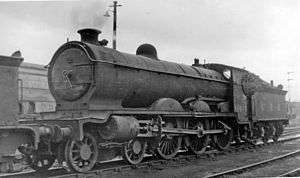Caledonian Railway 60 Class
The Caledonian Railway 60 Class were 4-6-0 passenger engines designed by William Pickersgill and introduced in 1916. Six were built by the Caledonian Railway at its own St Rollox works in 1916–17, and all of them passed into LMS ownership in 1923. A further twenty locomotives of a slightly modified design were built by the LMS under the auspices of George Hughes in the period 1925–1926.
| Caledonian Railway 60 Class (details for original CR batch) | |||||||||||||||||||||||||||||||||||||
|---|---|---|---|---|---|---|---|---|---|---|---|---|---|---|---|---|---|---|---|---|---|---|---|---|---|---|---|---|---|---|---|---|---|---|---|---|---|
 Pickersgill/Hughes 4P 4-6-0 No. 14640 at Motherwell Locomotive Depot, 15 August 1948. | |||||||||||||||||||||||||||||||||||||
| |||||||||||||||||||||||||||||||||||||
| |||||||||||||||||||||||||||||||||||||
| |||||||||||||||||||||||||||||||||||||
| |||||||||||||||||||||||||||||||||||||
The 60 Class were rugged and free steaming, but were unsophisticated and of lethargic performance for their size. Although classified as passenger locomotives by the LMS, latterly they spent much of their time on goods trains and acquired the nickname Greybacks, either in reference to their long and grimy boilers or possibly as an insult from former Glasgow and South Western Railway enginemen[1] ('greyback' being an old term for louse). Withdrawals began in 1944 but twenty three passed into British Railways ownership in 1948. The last locomotives were withdrawn from service in 1953, and all were scrapped.
Numbering and Locomotive Histories
| CR no. | LMS no. | BR no. | Built | Works | Withdrawn | Notes |
|---|---|---|---|---|---|---|
| 14630 | 54630 | 7/1925 | St Rollox | 12/1951 | ||
| 14631 | 54631 | 11/1925 | St Rollox | 5/1948 | BR number never carried | |
| 14632 | 1/1926 | St Rollox | 7/1947 | |||
| 14633 | 5/1926 | St Rollox | 3/1946 | |||
| 14634 | 54634 | 5/1926 | St Rollox | 11/1952 | ||
| 14635 | 54635 | 6/1926 | St Rollox | 1/1952 | ||
| 14636 | 54636 | 6/1926 | St Rollox | 2/1953 | ||
| 14637 | 54637 | 7/1926 | St Rollox | 3/1948 | BR number never carried | |
| 14638 | 54638 | 7/1926 | St Rollox | 5/1951 | ||
| 14639 | 54639 | 8/1926 | St Rollox | 12/1953 | ||
| 14640 | 54640 | 8/1926 | St Rollox | 10/1952 | ||
| 14641 | 54641 | 9/1926 | St Rollox | 11/1948 | BR number never carried | |
| 14642 | 54642 | 9/1926 | St Rollox | 10/1949 | ||
| 14643 | 54643 | 10/1926 | St Rollox | 2/1948 | BR number never carried | |
| 14644 | 54644 | 10/1926 | St Rollox | 4/1948 | BR number never carried | |
| 14645 | 54645 | 11/1926 | St Rollox | 7/1950 | BR number never carried | |
| 14646 | 54646 | 11/1926 | St Rollox | 3/1949 | BR number never carried | |
| 14647 | 54647 | 11/1926 | St Rollox | 3/1951 | ||
| 14648 | 54648 | 12/1926 | St Rollox | 11/1951 | ||
| 14649 | 54649 | 12/1926 | St Rollox | 10/1951 | ||
| 60 | 14650 | 54650 | 11/1916 | St Rollox | 9/1953 | |
| 61 | 14651 | 54651 | 12/1916 | St Rollox | 3/1950 | |
| 62 | 14652 | 54652 | 1/1917 | St Rollox | 11/1948 | BR number never carried |
| 63 | 14653 | 54653 | 2/1917 | St Rollox | 7/1949 | BR number never carried |
| 64 | 14654 | 54654 | 3/1917 | St Rollox | 1/1952 | |
| 65 | 14655 | 4/1917 | St Rollox | 1/1944 | ||
Technical details
Pickersgill Caledonian Railway design
See box, top right.[5]
Hughes LMS development of Pickersgill design
The locomotives built by the LMS had slightly larger cylinders and weighed slightly less than the original CR locomotives. Details were as for the CR locomotives except:[6]
- Introduced: 1925
- Boiler Pressure: 180 psi (1,200 kPa)
- Two cylinders: 20.5 in × 26 in (521 mm × 660 mm)
- Loco Weight: 74.75 long tons (75.95 t)
- Tender Weight: 41.5 long tons (42.2 t)
- Starting tractive effort: 22,900 lbf (102 kN)
References
- Atkins, C. P. (1976), The Scottish 4-6-0 Classes, Ian Allan, p.53
- Longworth, Hugh (2005), British Railway Steam Locomotives 1948-1968, page 166
- "Rail UK Steam Loco Class Information". Railuk.info. Retrieved 26 May 2013.
- "Rail UK Steam Loco Class Information". Railuk.info. Retrieved 26 May 2013.
- "Rail UK Steam Loco Class Information". Railuk.info. Retrieved 21 June 2012.
- Atkins, C. P. (1976), The Scottish 4-6-0 Classes, Ian Allan, p.109
- Baxter, Bertram (1984). Baxter, David (ed.). British Locomotive Catalogue 1825–1923, Volume 4: Scottish and remaining English Companies in the LMS Group. Ashbourne, Derbyshire: Moorland Publishing Company.